Family : Pieridae

Text © Prof. Santi Longo

English translation by Mario Beltramini
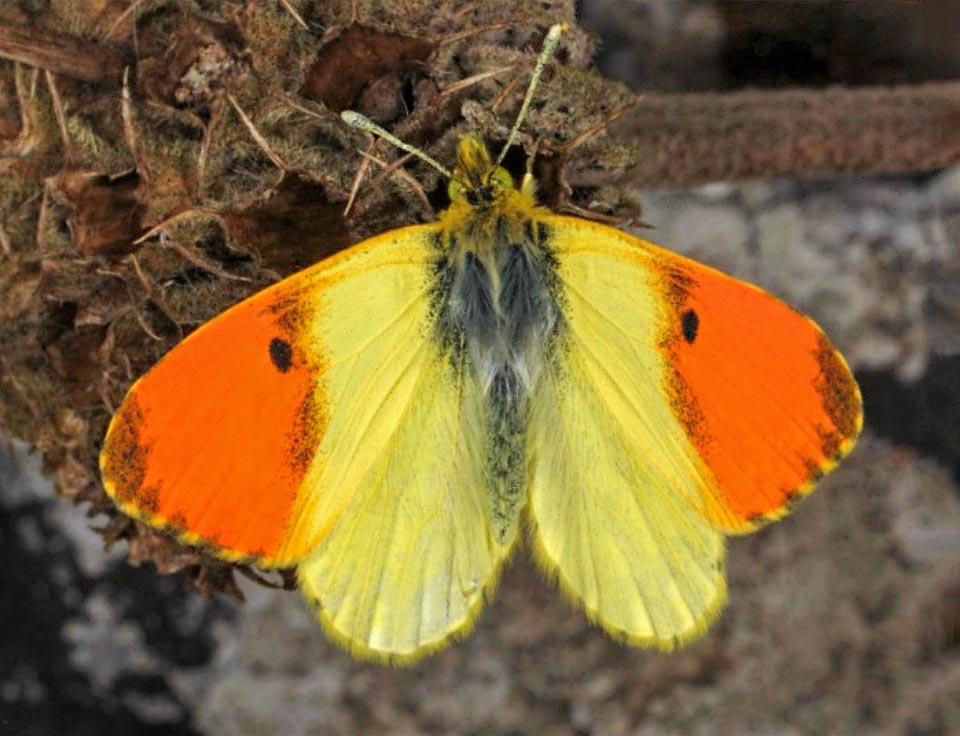
With an about 3,5-4 cm wingspan, the Aurora of Etna (Anthocharis damone) is present also in various Mediterranean locations where Isatis tinctoria, its host plant, grows © Wolfgang Wagner
The Eastern orange tip (Anthocharis damone Boisduval,1836), called in English “Orangetip” due to the bright orange colour of the males forewings, is a Rhopalocerous Lepidopteran, of the family Pieridae characterized by the adults having often white or yellow liveries.
In the females of this family the forelegs are reduced without nails and transformed in cleaning organs. In the males they are normally developed. Many species make long migrations. The eggs have the chorion with typical reliefs. The larvae have inconspicuous greenish liveries. The chrysalides of cingulated type, anchor to the supports with a belt formed by a silk thread.
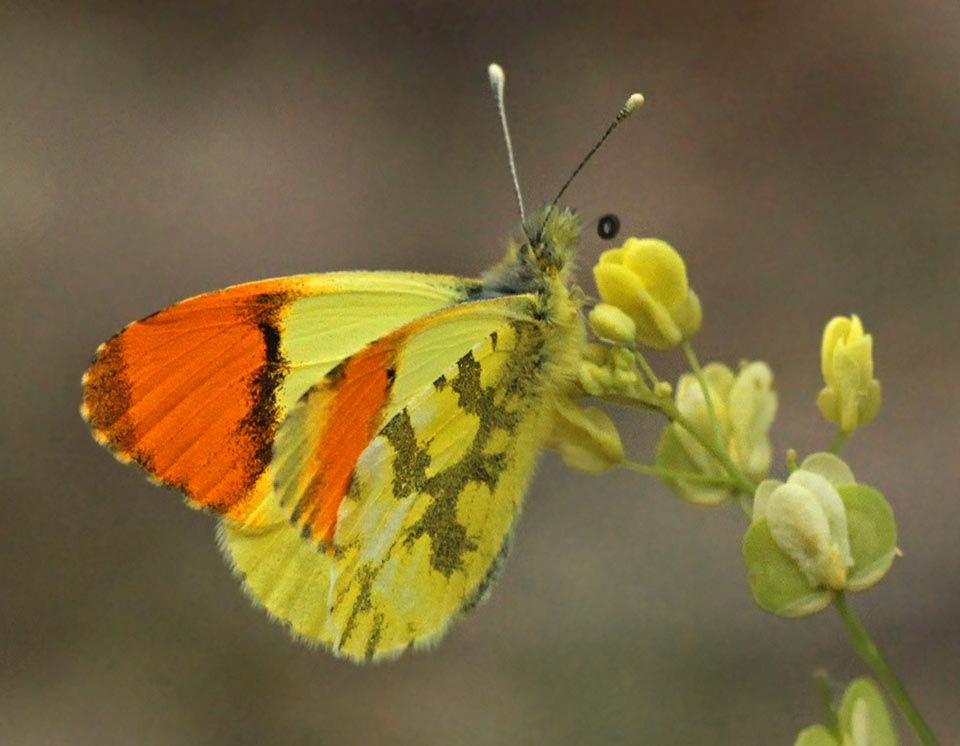
There is a remarkable sexual dimorphism. The upper pagina of the males wings has in fact an intense yellow colour with unmistakable orange apical spots on the forewings © Alan Cooper
The genus Anthocharis, meaning “graceful as a flower”, has been created by Boisduval and coll. in 1833; the name comes from the Latin “anthos” flower, and from the Greek “caris”, grace; whilst the specific one damone refers to the homonymous Greek musician of the V century BC, teacher and Pericles adviser.
Zoogeography
The Pierid has a fragmented distribution area; it has been collected in 1824 by Lefevre on the Etna, where it is present from 600 to 1200 m of altitude, and has been described by Boisdual, in 1836.
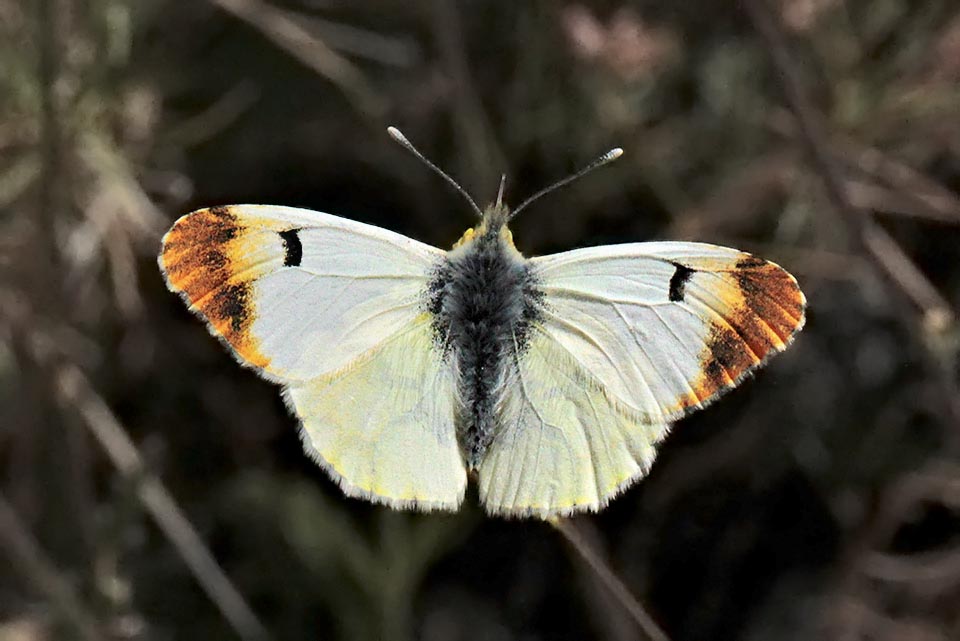
The females, bigger than males, are dorsally white with black apical spots, whilst the lower pagina of the hindwings is like light greenish drawings © Alan Cooper
It is common in Calabria (Aspromonte and Pollino), in Greece, Macedonia, Albania, Serbia, Turkey, Anatolia, Israel, Lebanon, Iraq and Iran in the locations where Isatis tinctoria, its host plant of Asian origin, grows.
In Asia are reported other host plants of the genus Isatis.
In some zones of the southern Balkans it is present with its congener Anthocharis gruneri.
Ecology-Habitat
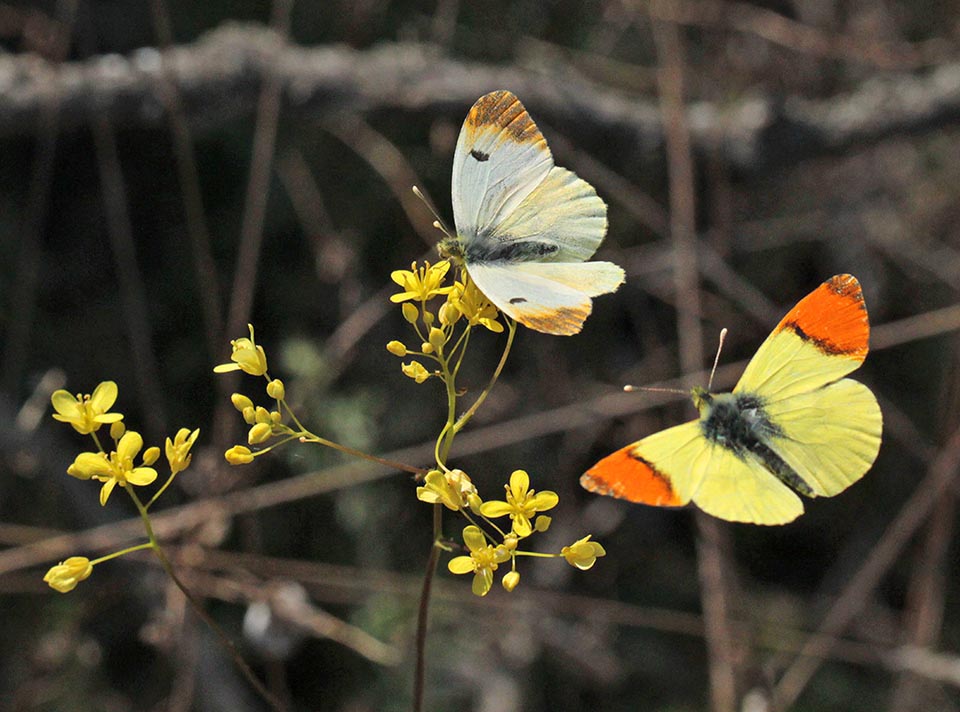
Couple with flying male attracted by the flowers of Isatis tinctoria, the host plant, and by the sexual pheromones emitted by the female © Alan Cooper
It mainly lives along the grassy banks or the steep slopes with rocks and open land where the host crucifer grows.
This biennial herbaceous plant has the basal leaves arranged in rosette, petiolate, whilst those of the stem are sessile and gradually smaller of glaucous green colour. The inflorescence is a corymbose raceme; the corollas are yellow.
Known as Woad or Blue plant, it is vastly spread all over Italy where it is believed that has been introduced in the Neolithic, by the Cathars in Piemonte to obtain the “pastel blue” dye, utilized in the textile industry, for such purpose from the XIII to the XVIII century has been cultivated in Tuscany, Umbria, Latium and Marches.
Due to its solidity, it was utilized in the medieval tapestries that have reached, unchanged, our times.
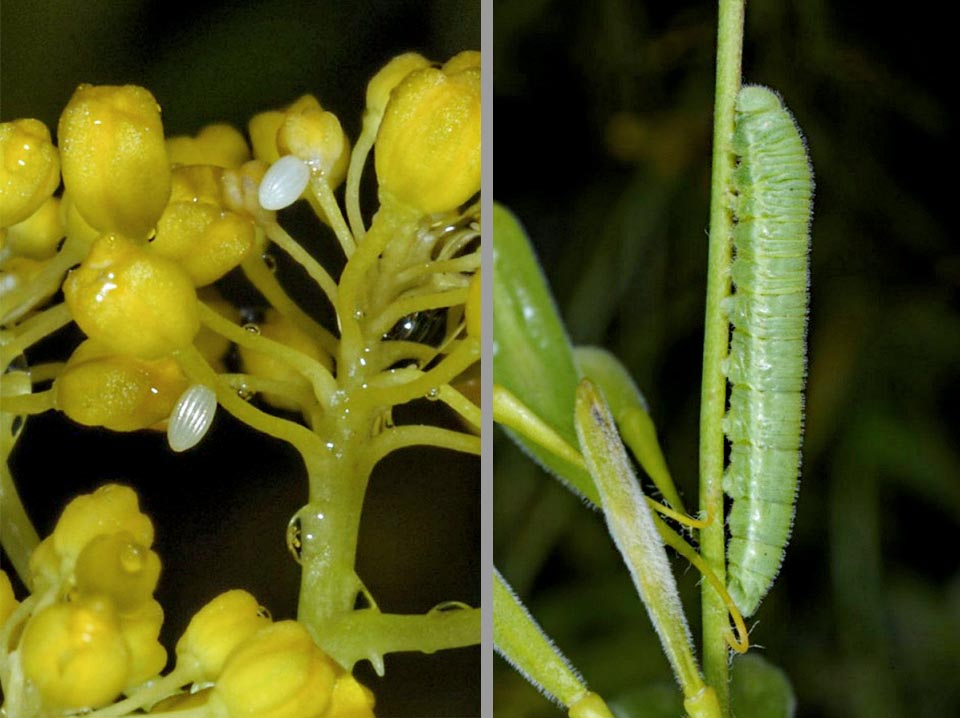
Just laid eggs with the characteristic reliefs of the chorion (left) and a larva that has already assumed the green colouration (right) © Wolfgang Wagner
The Woad was one of the dyes once used for the dyeing of the strong cloth used for fabricating the blue jeans.
Morphophysiology
The species has a remarkable sexual dimorphism; the wingspan of the adults varies from 3,5 to about 4 cm. In the males the upper pagina of the forewings is of intense yellow colour with orange apical spots limited by darker shades at the base and at the apex that evokes the golden, pink or purple colour of the sky after the sunrise. The upper pagina of the hindwings is wholly yellow, whilst the lower one displays a series of green spots on a yellow background that can be seen in transparency on the upper one.
The females of Anthocharis damone are bigger than the males.
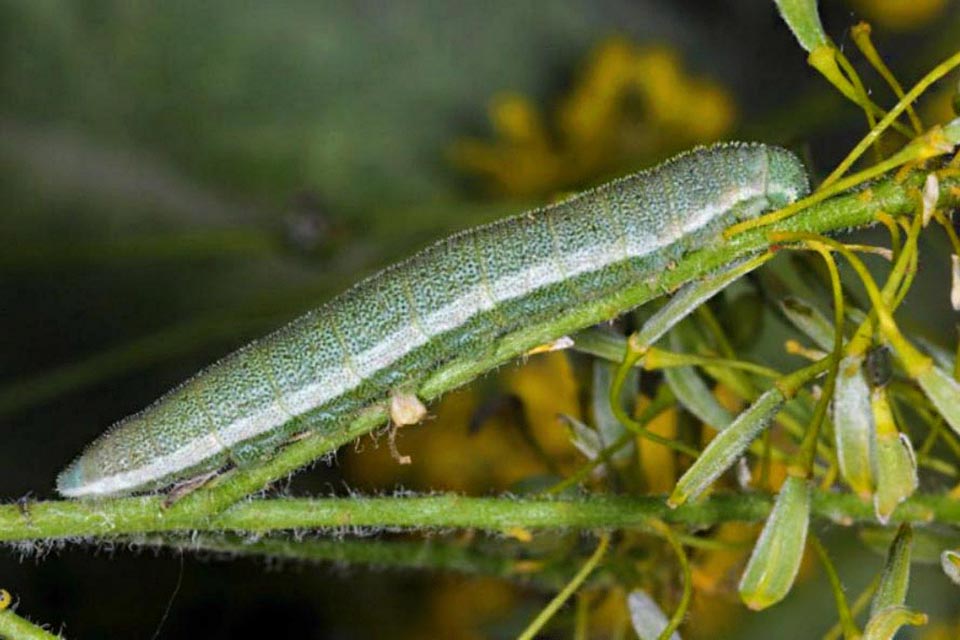
The growth of the caterpillar is completed in about two months. Here eopupa mature larva, about to pupate © Wolfgang Wagner
The forewings are dorsally white with two showy black spots at the margin of the discoid cell, and apical light brown, black streaked, bands. The lower pagina is slightly veiled in yellow, similar to those of the males.
Conversely, the adults of the congener Anthocharis gruneri, very similar, are smaller and have a pale yellow colouration. The lower pagina of their hindwings is of a relatively intense green colour on a white background.
The eggs of the Eastern orange tip are fusiform, about 4 mm long, of yellowish colour with longitudinal ribs. The newborn larvae have a yellowish body; during the following stages they get a greyish pinkish colouration with paler pleural bands, inconspicuous. The greyish pinkish coloured chrysalides recall the shape of the hull of a boat.
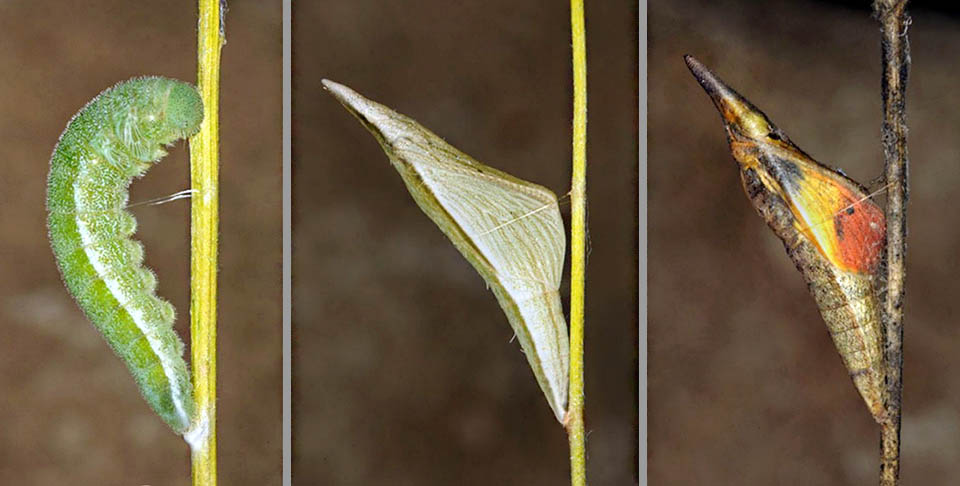
Successive stages of metamorphosis of Anthocharis damone. Left, eopupa enclosed by a robust small silky cord for anchoring firmly to support, centre, newly formed pupa like the hull of a boat. The pupa on the right allows to glimpse the red-orange wings of a male ready for flickering. This species spends wintertime in the stage of chrysalis © Wolfgang Wagner
The mature larvae, before incrisalidating, get encircled by a robust silky cord for anchoring to the support.
Ethology-Reproductive Biology
The species spends the wintertime in the stage of chrysalis anchored to various supports. In the hilly zones the pupal development completes in March and the flickerings continue gradually up to the month of June. In Asia, the flights are reported especially in July and August.
The adults are attracted by the lively coloured flowers preferably by the yellow ones whose nectar they nourish of. The females are poorly mobile and call the males with the sexual pheromones.
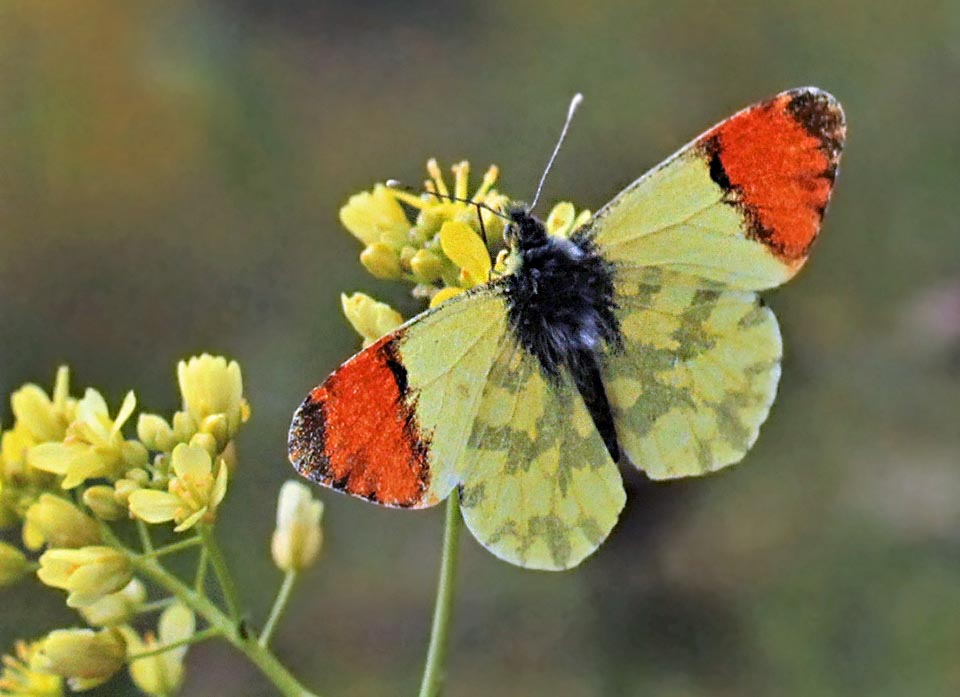
Here it is on Isatis tinctoria. The Aurora of Etna is now at risk because due to the climate changes the blooming of the plant is often in advance on the presence of the adults © Alan Cooper
After the fecundation the females lay the eggs in the lively yellow buds of the flowers of Isatis tinctoria. The larvae gnaw the leaves completing their development in about two months depending on the environmental temperatures.
The Aurora of Etna is at risk of extinction especially due to the climate changes that, in many zones, cause the blooming of the host plant earlier than the presence of adults.
Synonyms
Anthocharis damone damone, Winhard, 2000; Anthocharis damone fickeri, Winhard, 2000; Anthocharis damone eunomia Korb et Bolshakov, 2011.
→ For general notions about the Lepidoptera please click here.
→ To appreciate the biodiversity within the BUTTERFLIES please click here.
